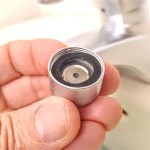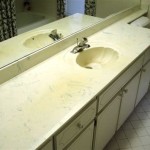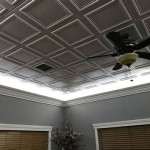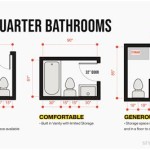Standard Hole Size for Bathroom Faucet Installation
Bathroom faucet installation, whether a replacement or a new fixture, requires careful consideration of several factors. One crucial aspect is the hole size in the sink or countertop. Incorrect hole sizing can lead to installation difficulties, potential damage to the sink or countertop, and, ultimately, a non-functional faucet. Understanding standard hole sizes is essential for ensuring a smooth and successful faucet installation.
The plumbing industry adheres to established standards for faucet hole configurations. These standards are designed to facilitate compatibility between different faucet models and sink designs, streamlining the installation process. While variations exist, particularly with older installations or specialized faucet styles, familiarizing oneself with the generally accepted dimensions is vital for proper planning and execution.
Understanding the Significance of Standard Hole Size
The standard hole size for bathroom faucets is not arbitrary; it is a carefully considered dimension based on the design and functionality of the faucet itself. The size and spacing of the holes directly impact the faucet's stability, water flow, and overall aesthetic appeal. If the holes are too small, the faucet shank, the part that extends through the sink or countertop, will not fit. Conversely, if the holes are too large, the faucet may not sit securely, potentially leading to leaks and movement.
Furthermore, the spacing between the holes is equally critical. Faucets are designed to align with specific hole configurations. If the spacing is incorrect, the faucet will not be able to connect properly to the water supply lines, rendering it unusable. Standardized hole sizes and spacing ensure that a wide range of faucets can be installed in a variety of sinks and countertops, providing flexibility and ease of replacement.
Incompatibility between the faucet and the sink’s pre-drilled holes often necessitates modifications, which can be costly and time-consuming. These modifications might involve drilling new holes, filling existing ones, or using adapter plates. While these solutions are possible, they are best avoided by initially selecting a faucet that is compatible with the existing hole configuration.
Moreover, the countertop material must be taken into account. Drilling into certain materials, such as granite or marble, requires specialized tools and expertise to prevent cracking or chipping. It is always prudent to consult with a professional plumber or countertop installer before attempting any modifications to the sink or countertop.
Common Faucet Hole Configurations and Dimensions
Different types of bathroom faucets require varying hole configurations. The most common configurations include single-hole, center-set, and widespread faucets. Each of these configurations has specific hole size and spacing requirements that must be met for proper installation.
Single-Hole Faucets: As the name suggests, single-hole faucets require only one hole in the sink or countertop. This hole typically measures 1 3/8 inches (35 mm) in diameter. Single-hole faucets are often paired with sinks that have a minimalist design and are commonly found in modern bathrooms. The faucet body and spout are usually integrated into a single unit, simplifying the installation process. Many single-hole faucets also include an optional escutcheon plate, which covers any pre-existing holes in the sink and provides a cleaner look.
Center-Set Faucets: Center-set faucets are designed for sinks with three holes, where the holes are spaced 4 inches apart. The center hole, which accommodates the faucet spout, typically measures 1 1/4 inches (32 mm) in diameter. The two outer holes, which are used for the hot and cold water handles, are typically the same size as the center hole. Center-set faucets are generally more compact than widespread faucets and are suitable for smaller bathrooms.
Widespread Faucets: Widespread faucets are also designed for sinks with three holes, but the holes are spaced further apart, typically ranging from 6 to 12 inches. The center hole diameter is usually around 1 1/4 inches (32 mm), similar to center-set faucets. Widespread faucets offer more design flexibility, allowing for separate hot and cold water handles that can be positioned at a greater distance from the spout. This configuration provides a more luxurious and spacious feel.
Besides these common types, there are also less frequent configurations, such as mini-widespread faucets (usually 4 inch spacing), and wall-mounted faucets which require specialized rough-in valves behind the wall and a different type of hole—or no hole at all—in the sink or countertop. It is crucial to identify the existing hole configuration before selecting a new faucet to ensure compatibility.
The given measurements are standard, however, specific faucet manufacturers sometimes deviate ever so slightly. Always check the manufacturer’s specification sheet before drilling any holes to ensure accurate sizing for the model in question.
Steps to Determine the Correct Hole Size and Configuration
Determining the correct hole size and configuration is a crucial step in selecting the appropriate bathroom faucet. Failing to do so can lead to installation problems and unnecessary expenses. A systematic approach is recommended to ensure accuracy and prevent complications. This involves measuring existing holes, identifying the faucet type, and consulting with professionals if needed.
Measuring Existing Holes: The first step is to accurately measure the diameter of the existing holes in the sink or countertop. This can be done using a measuring tape, a caliper, or a set of drill bits. Place the measuring tool across the center of the hole to determine its diameter. Record the measurement in inches or millimeters. If there are multiple holes, measure the distance between their centers to determine the spacing. This will help identify whether the configuration is center-set, widespread, or another less common type.
Identifying the Faucet Type: Once the measurements have been obtained, it's important to identify the type of faucet intended for installation. Single-hole faucets, center-set faucets, and widespread faucets all have different hole requirements. If replacing an existing faucet, examine the old faucet to determine its type. If installing a new faucet in a new sink, consider the overall design and aesthetic of the bathroom to choose a faucet type that complements the space.
Consulting with Professionals: If any doubt exists regarding the correct hole size or configuration, it is advisable to consult with a professional plumber or a bathroom renovation expert. These professionals possess the knowledge and experience to accurately assess the situation and provide guidance on the best course of action. They can also assist with any modifications that may be required, ensuring that the work is done correctly and safely. Attempting to modify the sink or countertop without the proper tools and expertise can result in damage and costly repairs.
When purchasing a new sink and faucet, often bundled deals exist which guarantee compatibility in terms of hole size and spacing. This simplifies the process for homeowners and reduces the risk of errors.
In addition, reviewing the technical specifications provided by the faucet manufacturer is critical. These specifications typically include detailed diagrams and measurements of the faucet, including the required hole sizes and spacing. Adhering to the manufacturer's recommendations will ensure a proper fit and prevent installation problems.
Ultimately, understanding the standard hole sizes for bathroom faucets and following a systematic approach to measurement and identification will contribute to a successful and hassle-free installation. This will not only save time and money but also ensure the longevity and functionality of the new bathroom fixture.

What Is Standard Size Hole For A Kitchen Or Bathroom Faucet

Bwe 10 2 In X 5 1 34 Brass Kitchen Sink Faucet Hole Cover Deck Plate Escutcheon Brushed Nickel P 22n The Home Depot

2 Handle 3 Hole Polished 8 Inch Widespread Bathroom Faucet Brushed Nickel With Pop Up Drain Phiestina

Standard Bathroom Sink Dimensions With Photos Upgradedhome Com

B613 Drop In 3 Faucet Holes Vanity Sink Bristol Sinks

Tahanbath 8 In Widespread 3 Holes Double Handles Bathroom Sink Faucet With Drain Brushed Nickel W122466237 Kxc The Home Depot

How To Calculate The Overhang And Reach Dimensions Of A Lavatory Faucet Moen Solutions

What S The Standard Faucet Hole Size Check Before You Buy

Ishiro Dowell 8 In Widespread 2 Handle Mid Arc Bathroom Faucet With Valve And Cupc Water Supply Lines Matte Black Smd0jn022063011 The Home Depot

Single Hole Bathroom Faucet Spout Height 4 33 Stain Resistant Com
Related Posts







